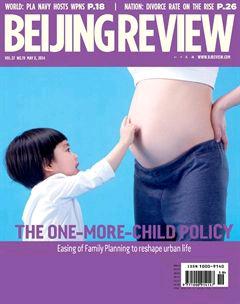A Change in Population Policy
Chinas recent relaxation of its family planning policy is a landmark change that is poised to contribute to a lasting and balanced development of the population and a healthy, stable development of society as a whole.
The new policy allows couples to have two children if one of the parents is an only child. Previously, a couple in urban areas could generally only have a second child if both parents were only children.
Issued last November, the policy is now in full swing in Beijing, Shanghai and Chinas wealthy Guangdong Province among other places. Hopefully, it will be extended to cover the whole country in 2015.
The commonly known one-child policy, which was implemented in the late 1970s, once made great contributions to easing pressures caused by rapid population growth in the underdeveloped economy. However, as circumstances change, its disadvantages—such as creating an aging society and labor shortages—are obvious.
According to statistics, the population aged 60 and above in China accounted for 14.3 percent of the whole in 2012. By the end of 2013, the population of this group had reached 200 million. This figure is predicted to hit 300 million in 2025 and 400 million in 2030.
If the country didnt reform its population policy, it would witness a sharp decrease in labor within a few decades. If that were allowed to occur, Chinas economic vigor and international competitiveness would be crippled. Against this backdrop, relaxing the family planning policy has become a common aspiration for all.
This relaxation marks an improvement of the existing family planning policy. On the one hand, it can recover the sex ratio of births to a normal level, strengthen a familys risk-resistance ability and allow for greater care of the elderly. On the other hand, it can continue to help stabilize a moderately low birth rate, thus slowing down the sharp drop after the population has reached an inevitable historical summit. Additionally, it can maintain a reasonable structure of labor.
As for concerns about creating a new baby boom, sociologists have argued there is no need to worry. The relaxation may lead to a moderate rebound of population, but a major baby boom is highly unlikely because the number of families meeting the requirement to have a second child is smaller than first estimated. During the past three decades since the family planning policy was carried out, terms were strictly implemented mainly in cities. In the vast rural areas, families continued to have more than one child, particularly if the first is a girl.

